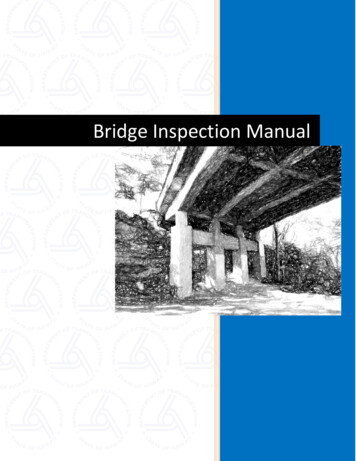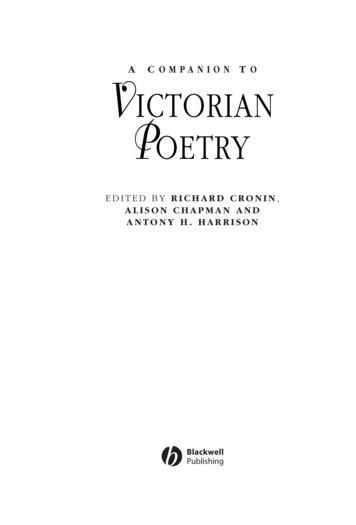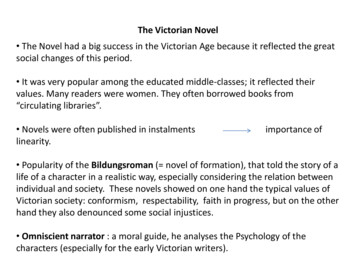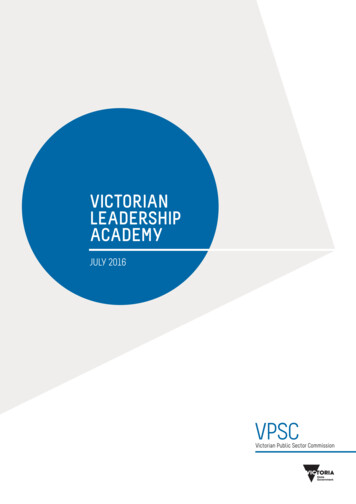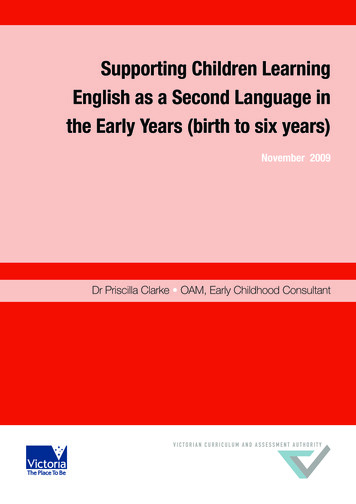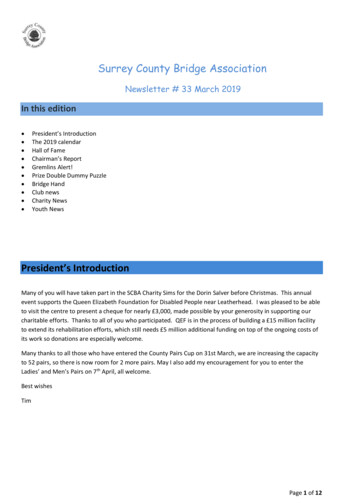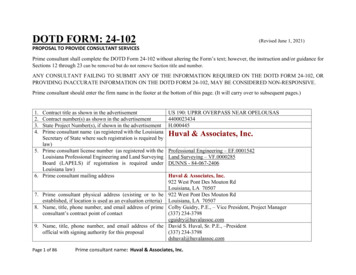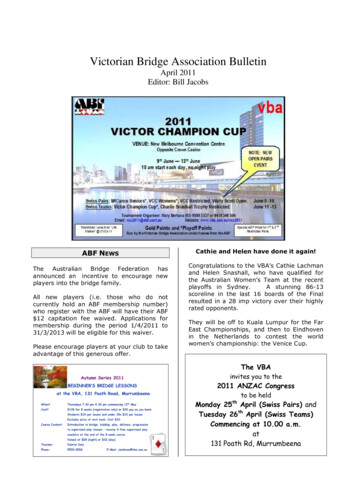
Transcription
Victorian Bridge Association BulletinApril 2011Editor: Bill JacobsABF NEWSThe Australian Bridge Federation hasannounced an incentive to encourage newplayers into the bridge family.All new players (i.e. those who do notcurrently hold an ABF membership number)who register with the ABF will have their ABF 12 capitation fee waived. Applications formembership during the period 1/4/2011 to31/3/2013 will be eligible for this waiver.Please encourage players at your club to takeadvantage of this generous offer.Cathie and Helen have done it again!Congratulations to the VBA’s Cathie Lachmanand Helen Snashall, who have qualified forthe Australian Women’s Team at the recentplayoffs in Sydney.A stunning 86-13scoreline in the last 16 boards of the Finalresulted in a 28 imp victory over their highlyrated opponents.They will be off to Kuala Lumpur for the FarEast Championships, and then to Eindhovenin the Netherlands to contest the worldwomen’s championship: the Venice Cup.The VBAinvites you to the2011 ANZAC Congressto be heldthMonday 25 April (Swiss Pairs) andTuesday 26th April (Swiss Teams)Commencing at 10.00 a.m.at131 Poath Rd, Murrumbeena
Page 2VBA Bulletin April 2011To the play!PANACHE - XIBen ThompsonIshmael Del’Monte, who we’re now claimingas a Victorian (he owns the Kings andQueens bridge club in Brighton), narrowlylost the final of the prestigious VanderbiltCup at the US Nationals last month to thepowerful squad that will be USA1 for theworld championships later this year. Thismonth’s hand is from the semi-final, whereIsh’s team won comfortably over theChinese-American Kang team.Dealer: WVul: E/W K64A98A86KJ87 AQ8724J9321092 J3K107651054A541095QJ32KQ7Q63At Ish’s table, and both tables in the othersemi-final, North opened 1NT (around 1517), got raised directly to 3NT, and madeeasily on the mundane heart lead from East.With Kang N/S, the auction had a bit morebite to it:WestPass1 PassPassNorth1 D’ble2NTPassEastPassPassPassPassSouth1 1NT3NTSouth’s 1 was a transfer to hearts. North’sdouble was a support double, showingexactly three hearts. Some people playsupport doubles as mandatory (you have todo it with 3-card support, even if you regretopening). Some play them as optional.Notice that all three Souths who faced astrong 1NT opening didn’t bother withStayman. With their sterile 4333 shape, theyjust bid 3NT directly. Even with a 4-4 heartfit, 4 would have to make two extra tricksto be right (ie NT making 8 tricks and heartsmaking 10 tricks), and that just isn’t likely.Wang for Kang got the 7 lead. Given theovercall, he assumed correctly that the Awas on his left, so he jumped up with the Kand oops.He had to knock out A, and when he did,East had a spade to return to his partner’snow-cashing suit.What should declarer have done? He shouldhave ducked the opening lead. There was norisk of the defence setting up a different suitsince he had all the other suits well held. Byducking, he could have sliced up thecommunication between the defenders’hands. East would have won the J, butWest’s spades wouldn’t have been set up yet,so E/W wouldn’t be able to cash the suitlater.If North as declarer receives the J lead, heshould also duck. In fact Fred Gitelman in theother semi-final got a heart lead but Jswitch in the mid-game when he didn’t knowyet if he had 9 tricks. He carefully andcorrectly ducked the J, and cruised home.Expert aside: Transfers after a 1 openingare now ubiquitous in the expert community1.Just like transfers over a 1NT opening, theygive you extra time and space to describeyour hand. And opener can describe hissupport better. Many experts deliberatelypack many of their balanced openings into1 , and that actually makes the transferresponses more effective.The takeawayBe careful when you take your finesse. Whenit wins can be as important as that it wins.NOT SO RECENT RESULTSRamsden Handicap Swiss Pairs (take 2)123V. Rugless – D. WilsonP. Nankin – A. RauchbergerJ. Collins – A. Czapnik(Apologies for the misreporting of this result last month.The editor had a senior moment.)1They are indeed ubiquitous. That doesn’t make themright. We’ll return to this topic BJ
VBA Bulletin April 2011Page 3MYSTERIES OF DEFENCEBill JacobsOne of the advantages of writing a series ofarticles about defence is that there is noshortage of material to choose from. In thefirst article I suggested that I averaged 5defensive blunders per session. If the threeother players at the table do likewise, thereare 20 defensive errors in a single session.Seeing them and analysing is easy enough –doing something about them is not so easy.This deal from the 2010 Victorian Open Pairsstruck me as instructive:Dealer: EVul: E/W 92KQ32974QJ108 A83874AQ53K75 654A10965102962KQJ107JKJ86A43WestNorthPassPass1NT2 EastSouthPass1 2 PassAll passI played 2 as South and West led 7. Eastwon A, dropping my J, thought for amoment, and returned a low heart.I gratefully threw a couple of diamonds ondummy’s KQ, as West looked a littledisgusted, then took the club finesse, Eastsignalling odd. West returned a club to myace, and now I played K winning, and a lowspade towards dummy’s 9. West stepped inwith A and returned a third spade.That drew trumps for me, and I was able tocross to dummy’s club to play the 13th club,pitching another diamond, and lose just thediamond ace. Making 9 tricks, 140, for an80% board.Well – you be the judge. How would youallocate the blame for this less-than-perfectdefence?The post-mortem was revealing.Eastjumped in and said: “I thought he was falseWest wascarding with that J, sorry”.pretty unhappy, but gracious about it. This isone of the better and more long-standingpartnerships at the VBA, and the postmortem suggested why.I allocate 20% blame to East and 80% toWest.East’s heart return was probably wrong. Forstarters, it’s not too likely that I wouldfalsecard with J from J84, throwing apotential trick in the heart suit for the sake ofdeception – East paid me quite a complimentby thinking I might have done so.More seriously, suppose West does ruff theheart – what is he to play next? A diamondor spade is leading up to declarer’s suits, andwhilst a club is probably safe (declarer willhave a singleton club in this scenario), willWest know that? East clearly didn’t give thisaspect any consideration.Still, the heart return could have been thewinner – for example, if declarer started with KQJ10x Jxx KQxx Ait’s the only defence to beat the contract!But whilst East’s defence was probablywrong, West’s was definitely wrong. Whenhe won the A, he had only to play a thirdclub, rather than a third spade, to put me indummy with trumps outstanding so I couldno longer enjoy the 13th club. The situationwas double-dummy at this point. Converting8 tricks into 9 actually cost E/W morematchpoints than converting 7 tricks to 8.West was upset with the earlier defence andnot thinking straight.How often has this happened to you?Something goes wrong in the defence –perhaps an unfortunate opening lead – andthen you lose concentration with the bad turnof events, make a mistake and it all getsworse. It’s a very common occurrence.I’ve said this before: bridge is an intenselyemotional game.One of the secrets ofimprovement is to remove, or at leastminimise, the emotional content. Mr Spock,of Star Trek fame, would be the world’s
Page 4VBA Bulletin April 2011greatestbridgeplayer. Mostof thematchpoints lost in this month’s deal weredue to emotion, not skill.SETTING TRICK - PROBLEMSProblem 1:Dealer: EVul: N/S K9862Q1043A842 WestNorthPassPassEastPassPassQ43J7J92J10976South4 INTERVIEW WITH FREDDIE SHEINWOLDAlfred (Freddie) Sheinwold (1912-1997) wasa major pioneer of bridge in the 20th century.Co-inventor of the Kaplan-Sheinwold system,he had many other roles, as a player,captain, administrator and prolific author.This ACBL interview was conducted in theearly 1990s.You are very special in the world of bridge.You’ve witnessed the history of bridge. Youwere there when Charles Goren was on thefront page of Time Magazine and you areprobably one of the few people who actuallymet the famous Ely Culbertson.Did I meet him?! I worked for him for a yearand a half and he fired me 12 times, whichmight not stand up to the modern recordsbut it was pretty good in those days.Partner leads A and correctly reads you fora 3-card holding. He switches to a trump toyour J and declarer's K. He wins the Qcontinuation with A and exits a third heart.Declarer puts out a spade (partner 5) anddummy's K is played, then another spade.Are you taking the right inferences?Problem 2:Dealer: NVul: E/W Q10432Q10924397Freddie Sheinwold (left) and Ely CulbertsonDid you like him? Were they jovial firings?J87J64AK102K63WestPassPassPass12 NorthPass1 23 PassEastPassPassPassPassSouth1 11 4 Precision: any 16 points0-7 pointsYou lead A and continue K, droppingdeclarer's Q, partner signalling odd. Youhave to find a switch to (a) a neutral trump(b) a spade (c) a club. You choose.Solutions on page 8.No, no – they were serious. We disliked eachother. I was in my very early twenties and Iwould take no nonsense from anybody; andhe was a man who had no respect foranybody, including himself. He was a conman, a crook, but a wonderful PR man.He wrote some of the best selling books ofhis time.Yes, his best sellers were about bridge – firstthe Blue Book, and then the Red Book on theplay of the cards. All of these were writtenfor him.By his wife? I heard that his wife Josephinewas the real power behind him. True or not?No, not true. He was the real power behindhis throne. She was a very lovely woman
VBA Bulletin April 2011Page 5and she was unfortunate enough to have adrinking problem, and he was sympatheticabout that, because one of his two brothershad a drinking problem also.I remember reading that Ely promoted bridgewith ego, sex and fear – they were the threethings he wanted to put into it, and thepeople loved it. That wouldn’t go down sowell today, would it?AFFILIATED CLUB NEWSThe Royal South Yarra Lawn TennisBridge Club has now affiliated with the ABF.Congratulations to the RSYLTBC – that’s anacronym-and-a-half.The club will holdduplicates on two Tuesdays each month, anda Duplicate Bridge Dinner every secondmonth when members may invite guests.Perhaps not, but people are used to that sortof thing today.He had a simple bidding system, didn’t he?Was that what made it so popular – his drive,but also the simplicity of the system?Yes, the original Culbertson system.Buteventually, he changed it – he copied theFour Aces system. Slavishly plagiarized it.He did make contributions – the 4-5 Notrumpconvention for example was his, and the socalled Josephine 5NT – the grand slam force.She didn’t like it a bit, but he did, and hemade it her invention. He had a sense ofhumour. He fired me several times that Ithought shed credit on me, but some of themwere because I was just stubborn. I thinkthere was a little to be said for him – but notvery much.RSYLTBC members (l-r): Jill Chambers, Lucille Steven,Bob Baenziger, Mary Church (convenor), Ann GlennyThe Traralgon Bridge Club has awarded lifemembership to two stalwarts of the club:THE TWELFTH TRICKDealer: NVul: N/SIMPsWest3 Pass AA108Q104AKQ763 J5QJ9754A62105North1 4NT6 EastSouth2 *3 5 PassAll Pass(l-r) Doreen King and Eula BeasleyDoreen King is a foundation member that hasworked on the club committee for the last 10years, and works in many areas of the club,including operating the dealing machine, andhelping out at Beginners classes andSupervised Play evenings.* weak jump overcallWest leads 5.What do you play fromdummy?Whether your play from dummyworks well or poorly, what do you do next?Solution on page 6.Eula Beasley is a past president of the club.As the highest ranked club member, she hasrepresented Traralgon with distinction both inMelbourne and interstate, and has taughtmany classes at the club.
Page 6VBA Bulletin April 2011For eight years, the Bairnsdale Bridge Clubhas run a red point teams event, the RivieraTeams, that requires players to enter aspairs. The director then sets up the teamswith the strongest pair teamed up with theleast experienced pair, and so on.The event has great support from thestronger players – they see it as a way ofputting something back into bridge andhelping new players to gain experience.Newer players are enthusiastic also, andenjoy coming back to the table to score up.The event is played on two Monday evenings,the second being on Melbourne Cup eve. In2010, the winning team (pictured below)included two new players, neither of whomhad any masterpoints.MEMORIES OF FRED ALTMANIan McCanceFred Altman was my partner during much ofthe later 1960s and early 1970s. In 1967 wewon an Australian Pairs and finished secondin a Butler to qualify for the Australian teamat the Olympiad in 1968. That would havebeen our best tournament. The team finished5th, not surprisingly given the calibre of ourteam-mates, Tim Seres, Dick Cummings,Denis Howard and Roelof Smilde. We alsocame third in the team-qualifying Butler in1972, but I was unable to travel.Fred was the best of partners - he neverasked why I did something stupid, he alwaysknew it was for an apparently good reason.His temperament was excellent, and fewcould match his skill at play of the hand. Hewas an ornament to bridge in Victoria.THE TWELFTH TRICKBill Jacobs (l-r) Judy Banks, Anna Kearon, Mary Windham-Smith,Wendy MartinCOMING UP AT THE VBA .FRED ALTMAN SWISS PAIRSDates: Wednesdays, April 6, 13, 20, 27, May 4Format: 10 rounds of 14 board matches, scoredvia imps against a datum. Held simultaneouslywith the Restricted Swiss Pairs (to qualify in theRestricted, each player must have less than 300masterpoints).This is the premier Swiss Pairs event on theVBA calendar.Defending Champs:Open: Chellia Arul – Andrew KaszubskiRestricted: Phillip Knightley – Larry Attwood AA108Q104AKQ763 Q8743K853J982 K108632K62J974J5QJ9754A62105You should play Q at trick 1. If this iscovered by the king, then the odds are verygood that the heart finesse is working – Eastis not likely to make a weak jump overcallwith two side kings.If the Q is covered with K, win A andtake the heart finesse.If the Q holds, as shown in the diagram,cash A and play a low trump from dummy(not the ace: take a look at what happens ifyou do). If someone wins K and gives theirpartner a ruff, you can count yourselfextremely unlucky. If that doesn’t happen,you can ruff a spade and claim soon after.
VBA Bulletin April 2011Page 7CASES FOR ACES – IXKICKING BACK EVEN MOREBill JacobsThese were the E/W cards on the penultimatedeal of the recent NOT Quarter Finals inCanberra: AK7QJ6532K2K910K109Q9AQJ10843Ben Thompson and I bid it as follows:West1 3 13 34 35 Pass1234East2 3 24 34NT45 Extra values with long but not strong heartsSets hearts as trumps, extra valuesCue bids, showing 1st or 2nd round controlBlackwoodSadly, clubs were led, and the defendersnavigated a club ruff to defeat 5 by a trick.And we lost the match by just 3 imps.This deal was played six times, and on fouroccasions, E/W strayed up to the 5-level.Two pairs managed to play safely in 4 .How could we have stayed at the 4-level?The early auction was ok – in fact, a pair oftwo-over-one bidders would do it similarly:1 -2 -2 -3 . The problems came later.Some ancient historyIn 1977, I was a callow 21-year-old, and BobGallus invited me to play with him in theAustralian Butler trials in Perth.Bob wascradle-snatching, seeing in me a more-orless blank canvas on which to paint hisinnovative ideas.He unleashed several concepts on me,including transfer-rebids-by-responder (!),but by far the most important was the ideathat you should know how many aces thepartnership has.His theory was simple. If you’ve agreed asuit in a game-forcing situation, the verynext thing you need to know is whether youare missing two aces. If you are, then thereis no point progressing past game.Putting his theory into practice, once ourpartnership had agreed a suit in a gameforce, the next step bid was Blackwood. Youdidn’t have to use the device – for example,with no interest in slam, or perhaps with avoid, you could do something else.This theory led to the amazing auction,reported in the May 2003 bulletin, where Boband Rob Smart had an auction involving asplinter bid, which was doubled by theopponents: when one of the Bobs passedthat double, the pass was alerted asBlackwood!To prove how strongly Bob felt about this,consider the simple Acol auction 1 - 1NT.For Bob, 1NT is a completely idle bid. Ifresponder has a suit of diamonds, hearts orspades, he would bid that suit.And withonly clubs, he would raise the natural 1 bid.So in 1977, he explained to me that the 1NTresponse to 1 must be Blackwood. Andthat’s how we played it.Back to the NOT handUsing Galluswood, this hand is duck soup.When West hears 3 , he has the perfecthand on which to check for aces: plenty ofsecond round controls, but a shortage of keycards.So he bids 3 , Blackwood, East gives the twokey-card response, and West signs off in 4 .And to the semi-finals we would haveprogressed.Will my partnership now switch to this newlower level of Blackwood?I doubt it. Wedon’t play Minorwood, Redwood or Kickbackeither, although we probably should.If I had to recommend one of these devices,it would probably be Redwood/Kickback: thebid of one higher than 4-of-the-agreed-suitas Blackwood. This is a genuine space-saver,not too hard to remember, and mostimportantly, it’s optional – you don’t have touse it. For me, that is the key downside ofMinorwood.
Page 8VBA Bulletin April 2011SETTING TRICK – SOLUTIONSRECENT RESULTSIan McCanceAilsa Tandy Eclectic PairsProblem 1 Dealer: EVul: N/S Monday Competition1 P. Fent – R. Stewart2 E. Windmiller – P. Hemingway3 P. Nolan – M. PorterK9862Q1043A842 AJ5A95AK876K5 Q43J7J92J10976107KQ10864325Q3Victorian Master PairsIt's clear that partner had a lot of high cards,and not wanting to broach clubs was hard putto find exits. Don't force him to find anotherone. Rise Q so that you can lead J.Problem 2 Dealer: NVul: E/W Q10432Q10924397 J87J64AK102K63 K55J9876Q10542A96AK873Q5AJ8 Section A1 R. Kaplan – A. Segal2 S. Klofa – R. Stewart3 B. Howe – S. WeiszSection B1 T. Chira – S. Arber2 E. Hardy – G. Wikinski3 L. Meyer – P. MoritzSection C1 E. Linton – E. Matheson2 D. Selwyn – M. Granovski3 D. Sharman – C. ArulSection D1 J. Adams – E. Hynes2 M. Yuill – M. Allison3 F. Engelman – A. GedgeOpen Butler Interstate – Stage 2Dummy's spades are a big threat and your Jis in the pocket, so passive is contraindicated. Leading a club could be wrong butit looks the best shot. Declarer's clubs couldgo away on spades but not vice versa. Wednesday Competition1 C. Arul – A. Kaszubski2 A. Hegedus – A. Mill3 R. Stewart – S. Vardi Vu-Graph quotes from Edgar Kaplan:An exchange between commentators Kaplanand Jean Besse:Besse:“Well you must do a lot of thingsbefore you can endplay East.”Kaplan: “Yes, but that’s your job, Jean. If youdon’t want to do a lot of things, then you muststay in Switzerland.”123J. Magee – T. StrongB. Wein – D. MorganG. Kilvington – I. McCanceThwaites Victorian Mixed PairsChampionship1 J. Thompson – B. Thompson2 M. Yuill – S. Klofa3 E. Hardy – L. GoldPlate1 P. Moritz – L. Meyer2 S. Stock – B . Tencer3 D. Jacobs – W. JacobsConsolation1 K. Bechet – C. Hughes2 M. Tencer – M. Chrapot3 J. Savage – C. Arul
Ishmael Del'Monte, who we're now claiming as a Victorian (he owns the Kings and Queens bridge club in Brighton), narrowly lost the final of the prestigious Vanderbilt . of Star Trek fame, would be the world's . Page 4 VBA Bulletin April 2011 greatest bridge player. Most of the

